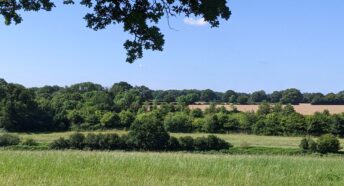Manston: the story moves forward

What is to be done with the Manston airport site? One of the most contentious issues in the county could have moved at least some way towards resolution with Thanet District Council’s Cabinet approval of its draft Local Plan for publication.
It of course covers a range of issues as the local authority sets out the isle’s planned development until 2031, but the subject that has attracted the greatest coverage and sparked the greatest division of opinion is the future of Manston.
Now, plans by site owner Stone Hill Park Ltd for 2,500 homes (a figure that could ultimately increase to 4,000), business units and sporting facilities would appear to have been backed with last Wednesday’s (October 25) approval of the Plan, which includes an allocation of 2,500 properties at the site.
A succession of operators struggled to make the airport work as a commercial venture and in May 2014 then-owner Ann Gloag, the joint founder of the Stagecoach bus company, closed it before selling a majority stake of the 750-acre site to “regeneration specialists” Chris Musgrave and Trevor Cartner, who rebranded it Stone Hill Park.
Alongside this, however, would-be airport operator RiverOak Strategic Partners (RSP) stated it had the plans and the funding in place for the site to be revived as a freight hub.
It says this would be a Nationally Significant Infrastructure Project and the Secretary of State can grant seizure of the site through a Development Consent Order (DCO).
It is intending to apply to the Planning Inspectorate for the DCO by the end of this year, with a subsequent decision from the Secretary of State expected by the end of 2018.
RSP says the granting of the DCO would allow it to have a a refurbished airport back in business by 2020.
Such hopes, however, took a nosedive when a TDC-commissioned report concluded that Manston was not viable as an operational airport.
It was subsequently little surprise when council policy incorporated Manston as a site suitable for redevelopment as something other than an airport.
CPRE Kent has been following the saga closely, producing a substantial response to RSP’s Manston Consultation earlier this year. It can be viewed here.
Commenting on the latest news, Hilary Newport, CPRE Kent director, said: “We believe in sustainable use of brownfield land, but it’s got to the right development in the right place.
“We trust that if the Stone Hill Park scheme does go ahead, it will negate the need to build on valuable agricultural land elsewhere in Thanet.”
Monday, October 31, 2017
- A number of important documents have yet to emerge. For example, a rigorous transport plan and a finalised air-quality assessment. The latter is critical given that allocations at Teynham will feed extra traffic into AQMAs.
- There seems to be no coherent plan for infrastructure delivery – a key component of the plan given the allocations being proposed near the already crowded Junction 7.
- There seems to have been little or no cooperation with neighbouring boroughs or even parish councils within Swale itself.
The removal of a second consultation might have been understandable if this final version of the plan were similar to that being talked about at the beginning of the consultation process. It is, however, radically different in the following ways:
- There has been a major shift in the balance of housing allocations, away from the west of the borough over to the east, especially around the historic town of Faversham. This is a move that raises many concerns.
- A new large allocation, with accompanying A2 bypass, has appeared around Teynham and Lynsted, to which we are objecting.
- Housing allocations in the AONB around Neames Forstal that were judged “unsuitable” by the council’s own officers have now appeared as part of the housing numbers.
- Most of the housing allocations being proposed are on greenfield sites, many of them on Grade 1 agricultural land – a point to which we are strongly objecting.
Concerns about the rush to submit the plan
The haste with which the plan is being prepared is especially worrying given the concentration of housing in Faversham. If the town is to take a large amount of new housing, it is imperative that the policies concerning the area are carefully worked out to preserve, as far as possible, the unique nature of the town. The rush to submit the plan is likely to prove detrimental.
As Swale does not have a five-year land housing supply, it is open to speculative development proposals, many of which would run counter to the ideas contained in the current plan. Some are already appearing. This is a common situation, and one that, doubtless, is a reason behind Swale’s haste.
Our overriding fear, however, is that this emphasis on haste is ultimately going to prove counterproductive. This is because it is our view that the plan, in its current form, is unlikely to pass independent examination. We are urging Swale to listen to and act upon the comments being made about the plan and to return the plan to the council with appropriate modifications before submitting it to the Secretary of State.
Essentially, this means treating the current consultation not as the final one but as the ‘lost’ second consultation.
The consultation ends on Friday 30 April and we strongly urge residents to make their opinions known if they have not already done so.
Further information








